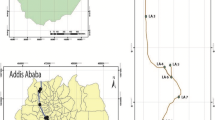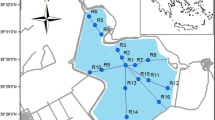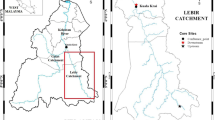Abstract
Sediment cores were collected at 5 stations in Lake Varese. They were analyzed for organic matter, N, P, organic C, Cd, Cr, Cu, Hg, Pb, Zn and PAHs. A sedimentological approach has been applied to estimate the ecological risk from identified pollutants.
As in other eutrophic lakes in Northern Italy, this lake is also at considerable risk from heavy metal pollution. Cr, Cu and Cd showed the highest enrichment factors for the last 5 years, 23.4, 8.0 and 7.6 respectively. Other metals had enrichment factors ranging from 1 to 3. Fluoranthene was chosen as a representative PAH, derived from combustion products; its average value in surficial sediments ranged from 100 to 220 ng l-1 dw. This compound can be a hazard to human health and aquatic life. An evaluation of radionuclide distributions after the recent Chernobyl accident in the USSR (134Cs, 137C s, 131I, 106Ru) provided useful tracers to follow the cycling of pollutants bound to particulate matter in the aquatic ecosystem.
Similar content being viewed by others
References
Baumann, P. C., W. D. Smith & M. Ribick, 1982. Hepatic tumor rates and polynuclear aromatic hydrocarbon levels in two populations of brown bullhead (Ictalurus nebulosus). In 'Polynuclear aromatic hydrocarbons: Sixth Int. Symp. on Biological Chemistry', M. W. Cooke, Dennis, A. J. & G. L. Fisher (eds), Battelle Press, Columbus, Ohio: 93–102.
Bedding N. D., A. E. Mc Intyre, R. Perry & J. N. Lester, 1982. Organic contaminants in the aquatic environment. I. Sources and occurrence. Sci. Total Envir. 25: 143–167.
Bloesch, J., 1977. Sedimentation rates and sediment cores in two Swiss lakes of different trophic status. In `Interactions between sediments and freshwater', Golterman, H. L. (ed.), Junk, The Hague: 65–71.
Brwen, H. J. M., 1966. Trace elements in Biochemistry. Academic Press, London, pp. 241.
Borneff, J. & K. Kunte, 1965. Carcinogenic substances in water and soil. Part XVII: Concerning the origin and estimation of the polycyclic aromatic hydrocarbons in water. Arch. Hyg. (Berlin) 149: 226–243.
US-EPA, 1973. Water Quality Criteria, 1972. Ecological Research Series, EPA R373033, Washington, D.C., pp. 594.
Galassi, S. & M. Mighavacca, 1986. Organochlorine residues in River Po sediment: testing the equilibrium condition with fish. Ecotoxicol. Envir. Saf. 12: 120–126.
Håkanson, L., 1980. An ecological risk index for aquatic pollution control. A sedimentological approach. Wat. Res. 14: 975–1001.
Håkanson, L. & M. Jansson, 1983. Principles of lake sedimentology. Springer-Verlag, New York, pp. 316.
Hansen, K., 1961. Lake types and lake sediments. Verh. Internat. Verein. Limnol. 14: 285–290.
Heit, M., 1985. The relationship of a coal fired power plant to the level of polycyclic aromatic hydrocarbons (PAH) in the sediment of Cayuga lake. Water Air Soil Pollut. 24: 41–61.
Heit, M. & Y. L. Tan, 1979. The concentration of selected polycyclic aromatic hydrocarbons in the surface sediments of some fresh and marine waters of the U.S. USDOE Rept. EML-353, New York, p. I–3 to I–39.
Karickhoff, S. W., V. S. Brown & T. A. Scott, 1979. Sorption of hydrophobic pollutants on marine sediments. Wat. Res. 13: 241–248.
Malins, D. C., B. B. McCain, D. W. Brown, S. L. Chan, M. S. Meyers, J. T. Landahl, P. G. Prohaska, A. J. Freidman, L. D. Rhodes, D. G. Burrows, W. D. Gronlund & H. O. Hodgins, 1984. Chemical pollutants in sediments and diseases of bottom-dwelling fish in Puget Sound, Washington. Envir. Sci. Technol. 18: 705–713.
Neff, J. M., 1979. Polycyclic aromatic hydrocarbons in the aquatic environment. Sources, fates and biological effects. Appl. Sci. Publ. LTD, London, pp. 262.
Parise, G. & G. Premazzi, 1986. I fenomeni di compattazione nella geocronologia dei sediments lacustri. Acqua e Aria 8: 783–790.
Pettersson, K. & B. Bostrom, 1986. Phosphorus exchange between sediment and water in Lake Balaton In 'Sediment and water interaction, P. G. Sly (ed.), Springer-Verlag, New York: 427–435.
Premazzi, G., 1979. The Cs-137 technique to evaluate recent sedimentation rates. Atti Convegno sull'Eutrofizzazione in Italia, (R. Marchetti ed.), CNR AC/2/45-70: 181–196.
Premazzi, G., A. Provini, G. F. Gaggino & G. Parise, 1986. Geochemical trends in sediments from 13 Italian subalpine lakes. In `Sediment and water interaction', P. G. Sly (ed.), Springer-Verlag, New York: 157–165.
Provini, A. & G. F. Gaggino, 1986. Depth profiles of Cu, Cr, and Zn in Lake Orta sediments (Northern Italy). In ‘Sediment and water interaction’, P. G. Sly (ed.), Springer-Verlag, New York: 167–174.
Scheiner, D., 1976. Determination of ammonia Kjeldhal nitrogen by indophenol method. Wat. Res. 10: 31–36.
Yulshamm, K. & O. R. Braekkan, 1975. Determination of trace elements in fish tissues by standard addition method. At. Absorp. Newlett. 14: 49–52.
Author information
Authors and Affiliations
Rights and permissions
About this article
Cite this article
Provini, A., Premazzi, G., Galassi, S. et al. Distribution of nutrients, trace elements, PAHs and radionuclides in sediment cores from Lake Varese (N. Italy). Hydrobiologia 176, 213–223 (1989). https://doi.org/10.1007/BF00026556
Issue Date:
DOI: https://doi.org/10.1007/BF00026556




